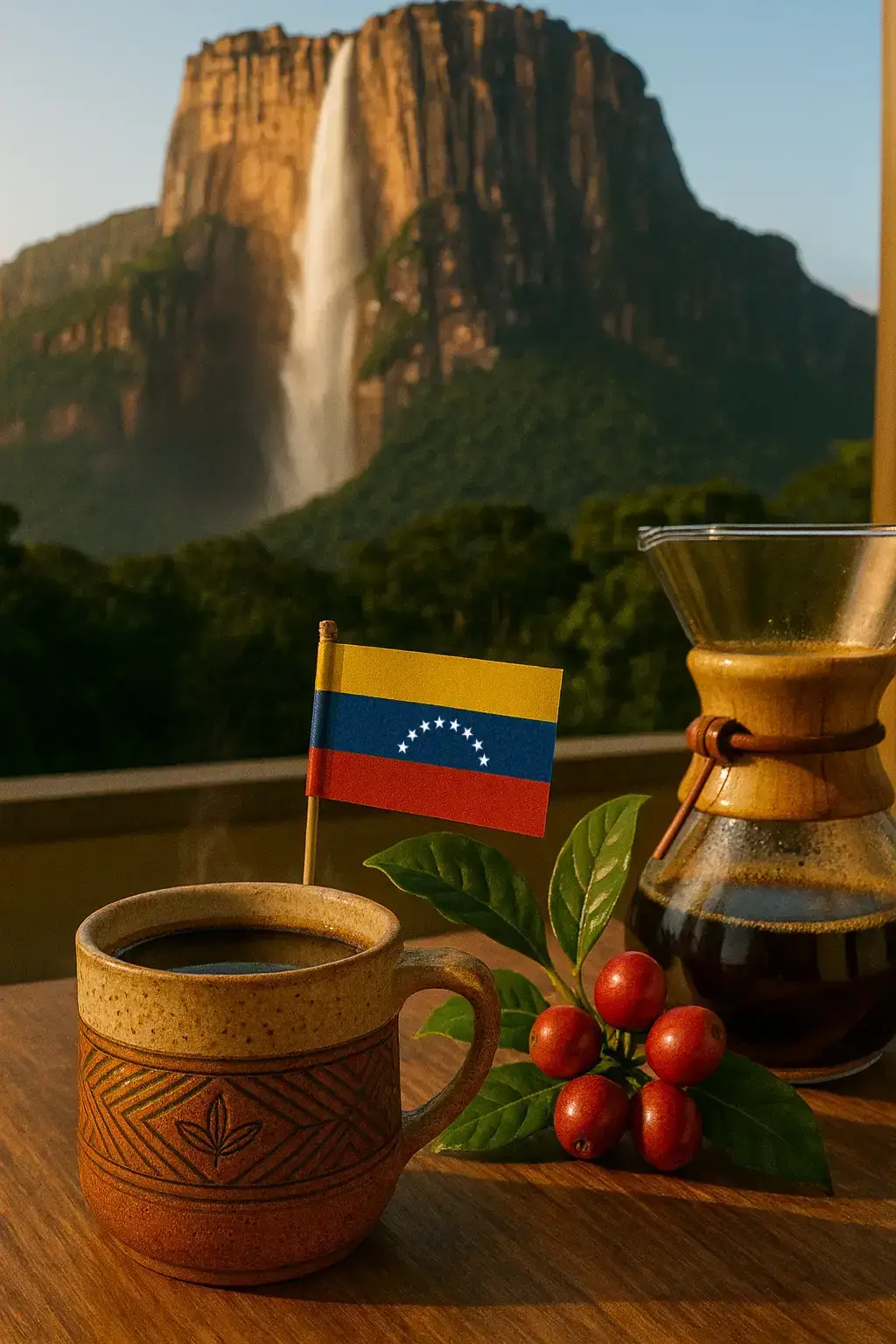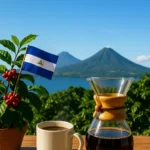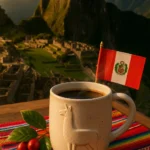Venezuelan coffee stands out. It’s unique, and coffee lovers seek it. You’ll notice its distinct qualities and rich flavor. This coffee balances well, has great acidity, and a captivating aroma. Its history ties closely to Venezuela’s culture.
- What defines Venezuelan coffee?
- What is the flavor profile of Venezuelan coffee?
- How do acidity, body, and aroma define Venezuelan coffee?
- What are the main coffee-growing regions and varieties of Venezuelan coffee?
- Where are the Andean Heights regions for Venezuelan coffee?
- What characterizes Venezuelan coffee from Zulia (Maracaibo)?
- What types of Venezuelan coffee come from Coastal Regions (Sucre and Aragua)?
- What other varieties and cultivation methods are used for Venezuelan coffee?
- Summary of Venezuelan coffee regions
- What is the rich history of Venezuelan coffee?
- How did Venezuelan coffee begin and grow historically?
- What led to the rise, decline, and revival of Venezuelan coffee?
- What is the cultural significance of Venezuelan coffee?
- What processing methods are used for Venezuelan coffee beans?
- How is Venezuelan coffee processed using the washed (wet) method?
- How is Venezuelan coffee processed using the natural (dry) method?
- How is Venezuelan coffee processed using the honey (pulped natural) method?
- How does Venezuelan coffee compare in the global landscape?
- What is the production scale and quality of Venezuelan coffee globally?
- How does Venezuelan coffee compare with Colombia and Brazil?
- What are common uses and preparation methods for Venezuelan coffee?
- What is Guayoyo coffee and how is it prepared?
- What other brewing methods are used for Venezuelan coffee?
- How is Venezuelan coffee culturally consumed?
What defines Venezuelan coffee?
Venezuelan coffee has a distinct profile. You’ll find elegant balance in its flavor:
- Fruity sweetness,
- Caramel and chocolate notes,
- Bright but smooth acidity,
- A clean, refreshing finish,
- A captivating aroma.
These traits truly make it special.
What is the flavor profile of Venezuelan coffee?
Venezuelan coffee offers a balanced, complex taste. Expect delightful fruit, caramel, and rich chocolate notes. Sometimes, you’ll pick up subtle tropical or citrus hints, a refreshing twist. This coffee avoids bitterness or burnt tastes. It gives you a clean, enjoyable experience. Different regions add unique flavors. Mérida, Táchira, and Caripe coffees, for example, offer sweetness with mild fruitiness. Think delicate clementine or mandarin, panela, and plum. Some hybrid types even taste like cashew fruit, adding to their smooth body.
How do acidity, body, and aroma define Venezuelan coffee?
Venezuelan coffee has superior acidity. It creates a clean aftertaste. The body is light but rich, and its aroma is floral with cocoa hints. Its acidity can be medium or bright, always balanced. This gives you a clean, pleasant aftertaste. It’s often less acidic than other Latin American coffees. You’ll notice a light but rich body, offering a smooth, velvety feel in your mouth. This makes the coffee easy to enjoy, yet still complex. The aroma? It’s captivating. Expect floral notes, a hint of earth, cocoa, and nuts. This creates a truly rich experience.
What are the main coffee-growing regions and varieties of Venezuelan coffee?
Venezuelan coffee grows in many different regions. Each area adds distinct flavors and characteristics to the beans. You’ll find farms in the Andean Heights, Zulia, and Coastal areas. They grow various Arabica types.
Where are the Andean Heights regions for Venezuelan coffee?
The Andean Heights include Trujillo and Mérida. These are top spots for growing high-quality Arabica coffee. Farmers mainly cultivate Typica and Bourbon varieties here. They grow coffee at high altitudes, from 1,200 to over 2,000 meters. This gives the beans balanced acidity, bright citrus, and clear fruity notes. You get a medium-bodied cup with a clean, crisp finish. Mérida coffee, a well-known specialty Arabica, stands out. It has strong floral and fruity notes, giving you a remarkably smooth experience.
What characterizes Venezuelan coffee from Zulia (Maracaibo)?
The Zulia region, around Maracaibo, grows a rare, prized bean: the Criollo coffee variety. Coffee from here is bold and full-bodied. It offers rich chocolate flavors and a complex aroma. This makes it perfect for espresso. Coffee lovers seek out its unique traits.
What types of Venezuelan coffee come from Coastal Regions (Sucre and Aragua)?
Coastal areas like Sucre and Aragua also produce much Venezuelan coffee. They grow Arabica types, like Typica and Caturra coffee variety. These coffees are typically milder. You’ll find nuanced flavors of caramel and delicate floral notes. They have a silky feel in your mouth, subtle and elegant.
What other varieties and cultivation methods are used for Venezuelan coffee?
Beyond those main types, Venezuela grows other coffee varieties. You’ll find Mundo Novo coffee variety and Robusta coffee variety, especially in the Maracaibo lowlands and Venezuelan Highlands. Farmers grow coffee at elevations from 300 to 1,800 meters. They often use shade for cultivation on small family farms. This helps create the high-quality specialty coffee Venezuela is now known for.
Summary of Venezuelan coffee regions
| Region | Main Varieties | Altitude | Flavor Notes | Body/Finish |
|---|---|---|---|---|
| Andean Heights (Trujillo, Mérida) | Typica, Bourbon | 1,200 – 2,000 m | Balanced acidity, bright citrus, fruity, floral | Medium body, clean, crisp |
| Zulia (Maracaibo) | Criollo | (Not specified, but lowlands mentioned later) | Bold, rich chocolate, complex aroma | Full-bodied, ideal for espresso |
| Coastal Regions (Sucre, Aragua) | Typica, Caturra | (Not specified) | Milder, caramel, delicate floral | Silky mouthfeel, subtle, elegant |
| Maracaibo Lowlands/Venezuelan Highlands | Mundo Novo, Robusta | 300 – 1,800 m (general) | (Not specified as distinct) | (Not specified as distinct) |
What is the rich history of Venezuelan coffee?
Venezuelan coffee cultivation has a rich history. It shaped the nation’s culture and economy for centuries. Coffee has always played a key role in Venezuela.
How did Venezuelan coffee begin and grow historically?
History tells us Capuchin missionaries brought coffee seeds to Venezuela around 1730. Jesuit priest José Gumilla also played a part in 1732, bringing seeds from Brazil. Coffee farming then spread from east to west. The first known planting in Caracas happened in the 1780s. People first drank it at the Blandin hacienda in 1786. Coffee quickly became a huge economic force. It boosted city growth and exports through vital ports like Maracaibo.
What led to the rise, decline, and revival of Venezuelan coffee?
Venezuela was once a top-three global coffee producer by the early 1900s. It held a strong spot in the world market. But the 20th century saw its coffee industry decline. The oil economy grew fast. This meant less money went into coffee farming, and infrastructure got worse. Despite these problems, the coffee community has started a revival. They focus on quality, not just how much they produce. This new effort has led to a jump in exports recently. It points to a comeback for specialty coffee from Venezuela, especially the high-grade Lavado Fino.
What is the cultural significance of Venezuelan coffee?
Coffee is more than just money in Venezuela. It has deep cultural roots. It’s part of the nation’s identity and daily life. Its influence touches everything, even music. Think of Hugo Blanco’s famous song, “Moliendo Café.” It uses coffee grinding to talk about time passing. It brings to mind quiet Venezuelan landscapes and the rhythm of farm life.
What processing methods are used for Venezuelan coffee beans?
How farmers process Venezuelan coffee beans truly changes their final flavor. They use washed, natural, and honey methods. Each one gives the coffee unique traits.
How is Venezuelan coffee processed using the washed (wet) method?
The washed process, or wet process, takes several steps. First, farmers pulp ripe coffee cherries to remove their outer skin. Then, beans ferment to break down the sticky layer. After that, they get a thorough wash. Finally, farmers carefully dry them. This method consistently gives you a clean, bright cup with clear acidity.
How is Venezuelan coffee processed using the natural (dry) method?
The natural process, or dry process, is coffee’s oldest method. Farmers dry whole coffee cherries without removing the fruit. This direct drying lets the fruit’s sugars and flavors soak right into the bean. This process usually adds more fruity and full-bodied characteristics to your coffee.
How is Venezuelan coffee processed using the honey (pulped natural) method?
The honey process, also called pulped natural, is a unique middle path. Farmers remove the coffee cherry’s skin. But they leave much of the sticky layer on the bean during drying. This remaining layer lets its natural sugars mix with the bean. This creates more sweetness and complexity. Variations, like white honey and red honey, depend on how much sticky layer stays on the bean.
How does Venezuelan coffee compare in the global landscape?
Venezuelan coffee stands in a distinct place globally. It’s known for its quality, not its sheer volume, especially when you compare it to bigger South American producers.
What is the production scale and quality of Venezuelan coffee globally?
Venezuela’s coffee production is small right now. It makes less than 1% of the world’s coffee, ranking about 26th. The country has faced a projected drop in how much it produces. Yet, recent numbers show a big jump in exports. In the first half of 2025, exports reportedly rose 500% compared to the year before. This suggests strong revival efforts. Venezuelan coffee is known for high quality, especially its “Lavado Fino” grade. People recognize its bright flavors and clean, crisp finish. This specialty coffee is mostly Arabica coffee. Farmers grow it at high altitudes (1000-1800m) under shaded forest canopies. It stands out by being less acidic and lighter-bodied than many other Latin American coffees.
How does Venezuelan coffee compare with Colombia and Brazil?
Venezuelan coffee is quite different from Colombian and Brazilian coffee. Think about how much they produce and where they stand in the market. Here’s how they compare:
- Production scale: Venezuela is small-scale, making less than 1% of world output. It ranks 26th, with recent export jumps but an overall decline. Brazil, by contrast, is the largest global producer. Colombia ranks second,
- Production volume: Venezuela made 310,000 bags in 2023, with a sharp drop expected. Colombia and Brazil produce millions of bags each year,
- Coffee type: Venezuela mostly grows Arabica in highlands, plus some Robusta in lowlands. Colombia largely focuses on Arabica. Brazil produces both Arabica and Robusta,
- Quality: Venezuelan coffee is known for high-quality “Lavado Fino” with bright, clean flavors and less acidity. Colombia and Brazil are well-regarded for their balanced, complex flavors across their huge production,
- Cultivation system: Venezuelan coffee often grows under shaded, multilayer forest canopies at 1000-1800m altitude. Brazil uses sun-grown plantations. Colombia uses mountain slopes.
What are common uses and preparation methods for Venezuelan coffee?
How you drink Venezuelan coffee depends on brewing methods, both old and new. Its unique qualities truly shine in different preparations.
What is Guayoyo coffee and how is it prepared?
The classic Guayoyo coffee is the quintessential Venezuelan brewing method. You filter hot water through ground coffee using a special cloth cone. People call this cone a manga or coffee sock. A manga is usually cotton sewn to a metal frame. You can adjust Guayoyo’s strength. It ranges from a lighter “soft” brew to a strong “cerrero” or “negrito.” Water temperature is key to avoid bitterness; never pour water hotter than 100°C directly onto the grounds. The coffee-to-water ratio is typically less than 80 grams per liter. This gives you a lighter, more nuanced cup.
What other brewing methods are used for Venezuelan coffee?
Beyond Guayoyo, espresso is common in Venezuelan cafes. It forms the base for popular drinks like Cafe con Leche, mixing espresso with warm milk for a rich, mild flavor. Venezuelan coffee shops also see more specialty methods. Brewers increasingly use tools like the Clever Dripper, AeroPress, and Chemex. This shows a growing interest in diverse coffee preparation.
How is Venezuelan coffee culturally consumed?
Venezuelan coffee culture means coffee is usually drunk black. Some people add a bit of sugar. But purists drink it plain to fully taste its complex aroma and distinct flavor. Coffee also appears in various cocktails. Its rich taste mixes with sweet liqueurs, showing a wider love for different drinks.
Venezuelan coffee offers a truly unique experience. It stands out with its balanced flavor, great acidity, and rich aroma. It was once an economic powerhouse, and now it’s a modern specialty coffee niche. This journey shows its lasting importance. Diverse regions—from Andean Heights to coastal areas—give it many exquisite flavors. Plus, coffee has unique cultural meaning. The traditional Guayoyo brewing method shows how vital it is to Venezuelan life. Even with smaller production today, Venezuelan coffee is a high-quality product. It deserves global recognition. Why not seek out this exceptional coffee yourself? Try brewing Guayoyo at home and discover its unique charm.









